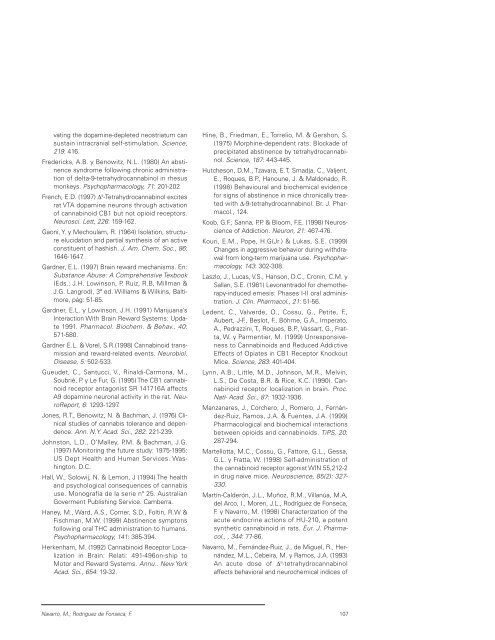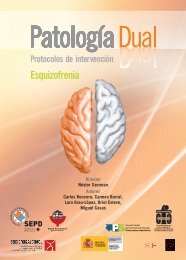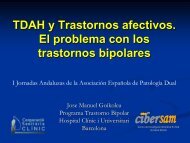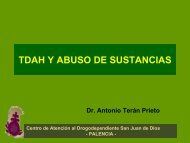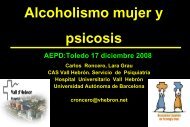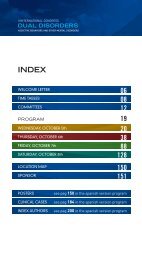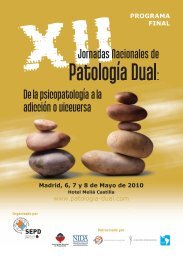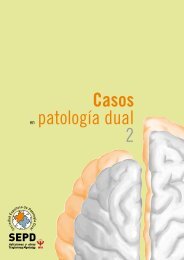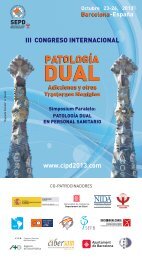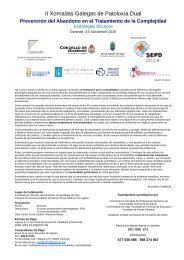Estos datos, refuerzan la importancia clínica<strong>de</strong> tener en cuenta las consecuencias alargo plazo <strong>de</strong>l consumo <strong>de</strong> haschish y abrenuna ventana conceptual para la comprensión<strong>de</strong>l fenómeno <strong>de</strong> la <strong>de</strong>pen<strong>de</strong>ncia a las drogas<strong>de</strong> abuso, que en el futuro probablementeproporcione un abordaje terapéutico.AGRADECIMIENTOSEste trabajo está financiado por lossiguientes Organismos: Ministerio <strong>de</strong> Educacióny Cultura DGICYT (PM 96/0047), LaDelegación <strong>de</strong>l Gobierno para el Plan NacionalSobre Drogas, La Comunidad Autónoma<strong>de</strong> Madrid (05/0024/99) y el Hospital Psiquiátrico<strong>de</strong> Ciempozuelos <strong>de</strong> la Or<strong>de</strong>n <strong>de</strong> SanJuan <strong>de</strong> Dios. Los autores quieren agra<strong>de</strong>cerel apoyo concedido por los citados Organismosy también muy especialmente la colaboración<strong>de</strong> los Dres. Luis Miguel García Seguray Julie Chowen <strong>de</strong>l Instituto Cajal, CSIC,Madrid, por su valiosa asistencia técnica.REFERENCIAS BIBLIOGRÁFICASAbood, M.E. y Martin, B.R. (1992) Neurobiology ofMarijuana Abuse. T.I.P.S., 13: 201.Aceto, M.D., Scates, S.M., Lowe, J.A. & Martin,B.R. (1995) Cannabinoid precipitated withdrawalby the selective cannabinoid receptor antagonist,SR 141716A. Eur. J. Pharmacol., 282:R1-R2.Ambrosio, E., Martin, S., García-Lecumberri, C &Crespo, J.A. (1999) The neurobiology of cannabinoid<strong>de</strong>pen<strong>de</strong>nce: Sex differences and potentialinteractions between cannabinoid andopioid systems. Life Sci., 65(6-6): 687-94.American Aca<strong>de</strong>my of Pediatrics Committee onSubstance Abuse (1999) Marijuana: A continuingContinuing Concern for Pediatricians.Pediatrics, 104(4): 982-985.Andreàsson, S., Allebeck, P., Engström, A. yRydberg, V. (1987) Cannabis and Schizophrenia:A longitudinaal study of Swedish conscripts.,Lancet, ii: 1483-1486.Anthony J.C., Warner, L.A., Kessler, R.C. (1994)Comparative epi<strong>de</strong>miology of <strong>de</strong>pen<strong>de</strong>nce ontobacco, alcohol, controlled substances, andinhalant: basic findings from the nationalcomorbidity survey. Exp. Clin. Psychopharmacol.,2: 244-268.Beardsley, P.M., Balster, R.L. & Harris, L.S. (1986)Depen<strong>de</strong>nce on thtrahydrocannabinol in rhesusmonkeys. J. Pharmacol. Exp. Ther., 239: 311-319.Castle, D.J. & Ames, F.R. (1996) Cannabis and thebrain. Austr. New Zeal.. J. Psych., 30: 179-183.Chen, J., Pare<strong>de</strong>s, W., Lowinson, J.H. y Gardner,E.L. (1990) ∆ 9 -Tetrahydrocannabinol enhancespresynaptic dopamine efflux in medial prefrontalcortex. Eur. J. Pharmacol., 190: 259-262.Corbett, D. y Wise, R.A. (1980): Intracraneal self-stimulationin relation to the ascending dopaminergicsystems of the midbrain: a moveableelectro<strong>de</strong> mapping study. Brain Res, 185:1.Crowley, T.J., Macdonald, M.J., Whitmore, E.A. &Mikulich, S.K. (1998) Cannabis <strong>de</strong>pen<strong>de</strong>nce,withdrawal, and reinforcing effects among adolescentswith conduct symptoms and substanceuse disor<strong>de</strong>rs. Drug Alcohol Depend., 50(1):27-37.Dewey, W.L. (1986) Cannabinoid Pharmacology.Pharmacol. Rev., 38(2): 151-178.Diana, M., Melis, M., Muntoni, A.L. & Gessa, G.L.(1998) Mesolimbic dopaminergic <strong>de</strong>cline aftercannabinoid withdrawal. Proc. Natl- Acad. Sci.,95: 10269-10273.Diana, M., Muntoni, A.L., Pistis, M., Melis, Miriam& Gessa, G.L. (1999) Lasting reduction inmesolimbic dopamine neuronal activity aftermorphine withdrawal. Proc. Natl- Acad. Sci.,11:1037-1041.Diana, M., Pistis, M., Carboni, S., Gessa, G.L. &Rossetti, Z.L. (1993) Profound <strong>de</strong>crement ofmesolimbic dopaminergic neuronal activityduring ethanol withdrawal syndrome in rats:Electrophysiological and biochemical evi<strong>de</strong>nce.Proc. Natl. Acad. Sci., U.S.A., 90: 7966-7969.Emrich, H.M., Leweke, F.M. y Schnei<strong>de</strong>r, U. (1997)Towards a Cannabinoid Hypothesis of Schizophrenia:Cognitive Impairments Due toDysregulation of the Endogenous CannabinoidSystem. Pharmacol. Biochem. & Behav., 56(4):803-807.Fray, P.J.; Dunnett, S.B.; Iversen, S.D.; Björklund, A.y Stenevi, U. (1983): Nigral transplants reinner-106Cannabinoi<strong>de</strong>s y conducta adictiva
vating the dopamine-<strong>de</strong>pleted neostriatum cansustain intracranial self-stimulation. Science,219: 416.Fre<strong>de</strong>ricks, A.B. y Benowitz, N.L. (1980) An abstinencesyndrome following.chronic administrationof <strong>de</strong>lta-9-tetrahydrocannabinol in rhesusmonkeys. Psychopharmacology, 71: 201-202French, E.D. (1997) ∆ 9 -Tetrahydrocannabinol excitesrat VTA dopamine neurons through activationof cannabinoid CB1 but not opioid receptors.Neurosci. Lett, 226: 159-162.Gaoni, Y. y Mechoulam, R. (1964) Isolation, structureelucidation and partial synthesis of an activeconstituent of hashish. J. Am. Chem. Soc., 86:1646-1647.Gardner, E.L. (1997) Brain reward mechanisms. En:Substance Abuse: A Comprehensive Texbook(Eds.: J.H. Lowinson, P. Ruiz, R.B, Millman &J.G. Langrod), 3ª ed. Williams & Wilkins, Baltimore,pág: 51-85.Gardner, E.L. y Lowinson, J.H. (1991) Marijuana’sInteraction With Brain Reward Systems: Update1991. Pharmacol. Biochem. & Behav., 40:571-580.Gardner E.L. & Vorel, S.R.(1998) Cannabinoid transmissionand reward-related events. Neurobiol.Disease, 5: 502-533.Gueu<strong>de</strong>t, C., Santucci, V., Rinaldi-Carmona, M.,Soubrié, P. y Le Fur, G. (1995) The CB1 cannabinoidreceptor antagonist SR 141716A affectsA9 dopamine neuronal activity in the rat. NeuroReport,6: 1293-1297.Jones, R.T., Benowitz, N. & Bachman, J. (1976) Clinicalstudies of cannabis tolerance and <strong>de</strong>pen<strong>de</strong>nce.Ann. N.Y. Acad. Sci., 282: 221-239.Johnston, L.D., O’Malley, P.M. & Bachman, J.G.(1997) Monitoring the future study: 1975-1995:US Dept Health and Human Services. Washington.D.C.Hall, W., Solowij, N. & Lemon, J (1994) The healthand psychological consequences of cannabisuse. Monografía <strong>de</strong> la serie nº 25. AustralianGoverment Publishing Service. Camberra.Haney, M., Ward, A.S., Comer, S.D., Foltin, R.W &Fischman, M.W. (1999) Abstinence symptonsfollowing oral THC administration to humans.Psychopharmacology, 141: 385-394.Herkenham, M. (1992) Cannabinoid Receptor Localizationin Brain: Relati: 491-496on-ship toMotor and Reward Systems. Annu.. New YorkAcad. Sci., 654: 19-32.Hine, B., Friedman, E., Torrelio, M. & Gershon, S.(1975) Morphine-<strong>de</strong>pen<strong>de</strong>nt rats: Blocka<strong>de</strong> ofprecipitated abstinence by tetrahydrocannabinol.Science, 187: 443-445.Hutcheson, D.M., Tzavara, E.T, Smadja, C., Valjent,E., Roques, B.P., Hanoune, J. & Maldonado, R.(1998) Behavioural and biochemical evi<strong>de</strong>ncefor signs of abstinence in mice chronically treatedwith ∆-9-tetrahydrocannabinol. Br. J. Pharmacol.,124.Koob, G.F.; Sanna, P.P. & Bloom, F.E. (1998) Neuroscienceof Addiction. Neuron, 21: 467-476.Kouri, E.M., Pope, H.G(Jr.) & Lukas, S.E. (1999)Changes in aggressive behavior during withdrawalfrom long-term marijuana use. Psychopharmacology,143: 302-308.Laszlo, J., Lucas, V.S., Hanson, D.C., Cronin, C.M. ySallan, S.E. (1981) Levonantradol for chemotherapy-induce<strong>de</strong>mesis: Phases I-II oral administration.J. Clin. Pharmacol., 21: 51-56.Le<strong>de</strong>nt, C., Valver<strong>de</strong>, O., Cossu, G., Petite, F.,Aubert, J-F., Beslot, F., Böhme, G.A., Imperato,A., Pedrazzini, T., Roques, B.P., Vassart, G., Fratta,W. y Parmentier, M. (1999) Unresponsivenessto Cannabinoids and Reduced AddictiveEffects of Opiates in CB1 Receptor KnockoutMice. Science, 283: 401-404.Lynn, A.B., Little, M.D., Johnson, M.R., Melvin,L.S., De Costa, B.R. & Rice, K.C. (1990). Cannabinoidreceptor localization in brain. Proc.Natl- Acad. Sci., 87: 1932-1936.Manzanares, J., Corchero, J., Romero, J., Fernán<strong>de</strong>z-Ruiz,Ramos, J.A. & Fuentes, J.A. (1999)Pharmacological and biochemical interactionsbetween opioids and cannabinoids. TiPS, 20:287-294.Martellotta, M.C., Cossu, G., Fattore, G.L., Gessa,G.L. y Fratta, W. (1998) Self-administration ofthe cannabinoid receptor agonist WIN 55,212-2in drug naive mice. Neuroscience, 85(2): 327-330.Martín-Cal<strong>de</strong>rón, J.L., Muñoz, R.M., Villanúa, M.A,<strong>de</strong>l Arco, I., Moren, J.L., Rodríguez <strong>de</strong> Fonseca,F. y Navarro, M. (1998) Characterization of theacute endocrine actions of HU-210, a potentsynthetic cannabinoid in rats. Eur. J. Pharmacol.,, 344: 77-86.Navarro, M., Fernán<strong>de</strong>z-Ruiz, J., <strong>de</strong> Miguel, R., Hernán<strong>de</strong>z,M.L., Cebeira, M. y Ramos, J.A. (1993)An acute dose of ∆ 9 -tetrahydrocannabinolaffects behavioral and neurochemical indices ofNavarro, M.; Rodriguez <strong>de</strong> Fonseca, F. 107
- Page 3:
IndicePRESENTACIÓN.Robles, G......
- Page 11 and 12:
desplazamientos, etc. La consecuenc
- Page 13 and 14:
lación automática su influencia n
- Page 15 and 16:
cos importantes que sostienen el co
- Page 17:
Navarro, M. Rodríguez de Fonseca,
- Page 20 and 21:
1. APROXIMACIÓN HISTÓRICA DELCANN
- Page 22 and 23:
Ayurveda siguió siendo el modelo a
- Page 24 and 25:
ningún dato significativo sobre su
- Page 26 and 27:
Los estudios de O`Shaughnessy facil
- Page 28 and 29:
gas legales y aparecieron en la Far
- Page 30 and 31:
Li H. L., Lin H. (1974) An archeolo
- Page 32 and 33:
gas, la adicción a las mismas, y l
- Page 34 and 35:
Figura 2.Tendencia del consumo en l
- Page 36 and 37:
eclutas que entre los estudiantes (
- Page 38 and 39:
una tasa significativamente inferio
- Page 40 and 41:
(7) Plan Nacional sobre Drogas: Enc
- Page 42 and 43:
1. ASPECTOS BOTÁNICOS.La Cannabis
- Page 44 and 45:
3) Tipo fibra, en el que el conteni
- Page 46 and 47:
dores, sin embargo, no habían apre
- Page 48 and 49:
ce unos efectos comportamentales mu
- Page 50 and 51:
nas plasmáticas y el resto a albú
- Page 52 and 53:
nistración oral que tras la subcut
- Page 54 and 55:
disminuye la agresividad causada po
- Page 56 and 57: Harvey D.J. (1990) Oxidative cleava
- Page 58 and 59: Valle J.R., Lapa A.J., Barros G.G.
- Page 60 and 61: 1. INTRODUCCIÓN.El primer paso imp
- Page 62 and 63: Los receptores CB 1 aparecen en eta
- Page 64 and 65: cio a la neurona, lo que origina en
- Page 66 and 67: Tabla 2. Localización de los endoc
- Page 68 and 69: Figura 3. Mecanismos de síntesis y
- Page 70 and 71: Tabla 3. Procesos cerebrales en los
- Page 72 and 73: SR141716A aumente la activación mo
- Page 74 and 75: des actuarían modificando la activ
- Page 76 and 77: 1998), movilización de ácido araq
- Page 78 and 79: Guzmán M., Sánchez C. (1999) Effe
- Page 80 and 81: Romero J., de Miguel R., García-Pa
- Page 83 and 84: Adicción y sistema cannabinoide en
- Page 85 and 86: RNAm del CB-1. Para confirmar este
- Page 87 and 88: cía un pequeño incremento de la a
- Page 89 and 90: ién del hecho de que el agonista d
- Page 91 and 92: volumen o Rodríguez de Fonseca et
- Page 93 and 94: eceptor antagonist SR 141716A affec
- Page 95: noid receptor knockout mice. Proc.
- Page 98 and 99: La utilización médica de las prep
- Page 100 and 101: que proyecta a estructuras cortical
- Page 102 and 103: de las señales nerviosas generadas
- Page 104 and 105: En el humano, la manifestación de
- Page 108 and 109: mesolimbic dopaminergic activity. B
- Page 110 and 111: A la hora de exponer de manera clar
- Page 112 and 113: parece tener relación con mecanism
- Page 114 and 115: tocolos de tratamiento, animales ut
- Page 116 and 117: Science and Medicine. Nueva York: R
- Page 118 and 119: de toxicidad neuroconductual, inter
- Page 120 and 121: (40), sin que influya en los efecto
- Page 122 and 123: 1.2.3. Neurotoxicidad.La neurotoxic
- Page 124 and 125: Tabla 2. CANNABIS: EFECTOS NOCIVOS
- Page 126 and 127: tener efectos mutágenos (2). Por o
- Page 128 and 129: Los efectos nocivos crónicos del c
- Page 130 and 131: puffs. J Pharmacol Exp Ther 1992 Ap
- Page 132 and 133: Nosologic discussion apropos of two
- Page 135 and 136: Cannabis: efectos nocivossobre la s
- Page 137 and 138: tura profesional en torno a los cua
- Page 139 and 140: Tabla 2. Episodios psicóticos con
- Page 141 and 142: Tabla 4. Síndrome amotivacional 1A
- Page 143 and 144: Delimitar con estudios controlados
- Page 145 and 146: female twins. Am J Psychiatry 1998;
- Page 147: tions of delta 9-tetrahydrocannabin
- Page 150 and 151: les sobre las propiedades terapéut
- Page 152 and 153: -Espasticidad muscular.• Escleros
- Page 154 and 155: Podemos concluir, que si bien está
- Page 156 and 157:
fumadores de marihuana un agravamie
- Page 158 and 159:
Es necesaria una investigación má
- Page 160 and 161:
léptico pues tiene un espectro de
- Page 162 and 163:
adrenérgicos: salbutamol, terbutal
- Page 164 and 165:
la administración de marihuana en
- Page 166 and 167:
loss in patients with AIDS”. J Pa
- Page 168 and 169:
as an effective antidepressant and
- Page 170 and 171:
FARMACOCINÉTICALos preparados del
- Page 172 and 173:
La detección de cannabinoides han
- Page 174 and 175:
Dewey WL. Cannabinoid pharmacology.
- Page 176 and 177:
En los jóvenes europeos que “sal
- Page 178 and 179:
en las dos últimas décadas y, en
- Page 180 and 181:
Por otro lado, cuando hablamos de u
- Page 182 and 183:
tan en el grado 9º (1º, 2º y 3º
- Page 184 and 185:
Kandel, D. (1975). Stages in adoles
- Page 186 and 187:
conocer el papel que juega la perso
- Page 188 and 189:
Tabla 2. Relación entre uso-abuso
- Page 190 and 191:
Tabla 4. Diferencias en el perfil E
- Page 192 and 193:
Tabla 6. Diferencias, expresadas en
- Page 194 and 195:
abstinentes se encuentran en percen
- Page 196 and 197:
BIBLIOGRAFÍA(1) Calafat Far A, Ame
- Page 198 and 199:
INTRODUCCIÓNDesde que inició su e
- Page 200 and 201:
Instrumento.La recogida de datos se
- Page 202 and 203:
mación recogida en la parte cualit
- Page 204 and 205:
Tabla nº 2: Características socio
- Page 206 and 207:
5. Los que consumen habitualmente c
- Page 208 and 209:
to “escalón” entre los proceso
- Page 210 and 211:
El gráfico también representa a l
- Page 212 and 213:
Tabla nº 7: Dejar de consumir cann
- Page 214 and 215:
Tabla nº 9: Dificultad relativa en
- Page 216 and 217:
Recibir aviso de familiares o amigo
- Page 218 and 219:
Droga “de moda” en el ambiente
- Page 220 and 221:
dísticamente al nivel .001) en el
- Page 222 and 223:
socialmente poco convencionales est
- Page 224 and 225:
sideran que la conducta en cuestió
- Page 226 and 227:
consumidores y abstinentes (consumi
- Page 228 and 229:
consuma en la actualidad con una ma
- Page 230 and 231:
BIBLIOGRAFÍAArthur M, Hawkins JD,
- Page 232 and 233:
“Se atribuye tal carácter benéf
- Page 234 and 235:
2. OBJETIVOS Y MÉTODO DEL ESTUDIOE
- Page 236 and 237:
nuestros días, están integradas e
- Page 238 and 239:
probado en alguna ocasión cannabis
- Page 240 and 241:
tro de rehabilitación acreditado.
- Page 242 and 243:
personajes, uno de ellos el histori
- Page 244 and 245:
asociaciones se hacen debates, se d
- Page 246 and 247:
todas ellas con una voluntad antipr
- Page 248 and 249:
La relación de convivencia y exclu
- Page 250 and 251:
a comprar, siempre lo han hecho los
- Page 252 and 253:
Cáñamo y cannabis como experienci
- Page 254 and 255:
el principio antrópico afirma que
- Page 256 and 257:
una línea argumental muy poderosa.
- Page 258 and 259:
difícil de abandonar para muchos j
- Page 260 and 261:
que presenta a Armstrong como otro
- Page 262 and 263:
hierbas y las drogas psicoactivas q
- Page 264 and 265:
sión oral dentro de su contexto o
- Page 266 and 267:
gos que pueden transformar el estad
- Page 268 and 269:
ógena, no es sino el reflejo, en n
- Page 270 and 271:
do con otras drogas como el éxtasi
- Page 272 and 273:
veías a la policía pasando por de
- Page 275 and 276:
Vieja historia del cannabis y recie
- Page 277 and 278:
general de consumidores de substanc
- Page 279 and 280:
nabis una etiqueta aconsejable para
- Page 281 and 282:
Enfoques preventivos del uso y abus
- Page 283 and 284:
las necesidades personales y social
- Page 285 and 286:
2. Un segundo tipo de conducta que
- Page 287 and 288:
de esos factores no parecen tan con
- Page 289 and 290:
Tabla 2. Edades de inicio de consum
- Page 291 and 292:
de tabaco en los niveles actuales.
- Page 293 and 294:
1998). De ahí que, sin olvidar que
- Page 295 and 296:
- Actividades de refuerzo de las cu
- Page 297 and 298:
Debemos reconocer que hoy por hoy l
- Page 299 and 300:
Hansen, W.B. (1992). School-based s
- Page 301 and 302:
Tratamiento del paciente cannábico
- Page 303 and 304:
1.TRATAMIENTO SINTOMÁTICOEn los pa
- Page 305 and 306:
olanzapina, risperidona y flupentix
- Page 307 and 308:
aqueje molestias y refiera síntoma
- Page 309 and 310:
cipios que en cesación del tabaqui
- Page 311 and 312:
B) TERAPIA GRUPALCuadro 10. Tratami
- Page 313 and 314:
Lo que nunca debe hacerse es sobrec
- Page 315 and 316:
El cannabis y sus derivados en elde
- Page 317 and 318:
CUADRO 1. ARTÍCULO 368 CÓDIGO PEN
- Page 319 and 320:
salud, con independencia de su form
- Page 321 and 322:
La alegación por la persona en pos
- Page 323 and 324:
do, STS de 21 de enero de 1998 y 21
- Page 325 and 326:
culo 374 CP, además de las penas s
- Page 327 and 328:
tración”. En igual sentido se ha
- Page 329:
10. CONCLUSIONESEl examen efectuado


